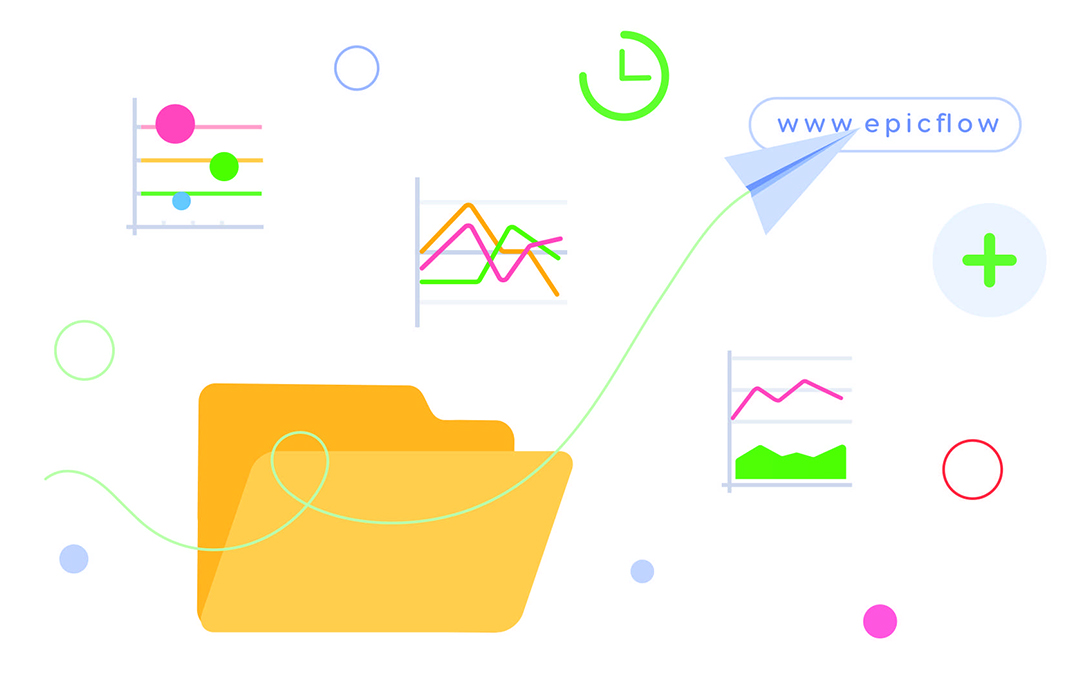Business organizations that run multiple complex projects, experience business growth, and at the same time have limited resources may require a more sophisticated approach to managing all their projects. In particular, they need to sort all their endeavors in line with the organizational goals and objectives. This is where project portfolio management (PPM) can help.
Read further to learn about more benefits of the PPM, how it differs from traditional project and program management, and how to manage your portfolio of projects in the most efficient way.
Project Portfolio Management: Essence and Importance
First, let’s define the concept of a project portfolio – it’s a collection of projects or programs whose implementation facilitates achieving a company’s strategic goals and objectives. Project portfolio management (PPM) is the process of selecting, prioritizing, and administering the portfolio of a company’s projects [1]. In addition to aligning them with business objectives, PPM takes into account a company’s capacity to complete them, so it also involves assessing resources available at the company (human, material, and financial) and assigning them to the projects that are most significant for an organization at the moment. As a result, each project a company implements contributes to achieving its goals and objectives, and available resources are utilized in an optimum way.
Project portfolio management isn’t a must for every business organization. Here are the examples of companies that are likely to implement PPM:
- Growing organizations with active project management activities;
- Companies running interrelated projects in which different departments are involved;
- Organizations that work on complex projects with limited resources and changing priorities;
- Companies that are striving to increase their project management maturity.
Therefore, project portfolio management is required by growing and fast-developing enterprises that seek to prioritize the projects they run and ensure their strategic alignment.
The difference between project, program, and portfolio management
To avoid confusion between all these concepts, let’s consider their meaning in more detail.
- According to the PMBOK Guide [2], a project is a temporary endeavor aimed at creating a product, or service, or achieving some other result. The purpose of project management is to guide this endeavor toward successful completion – to deliver it on time, within budget, and in line with customers’ expectations and existing constraints.
- A program embraces a set of projects that have a common value for a company. Program management involves coordination and control over this group of projects, ensuring that the team members perform the right work and the right time.
- Finally, a portfolio is a collection of projects and programs that have common strategic goals and objectives. The purpose of project portfolio management is not only running all of them but allocating resources effectively and ensuring strategic alignment.
Let’s now review why project portfolio management is so important for enterprises.
The benefits of project portfolio management
- Prioritizing projects running in an organization.
As a result of prioritization, a company can focus on the projects that will deliver maximum value for them for the moment.
- More efficient utilization of the available resources.
Assigning resources to the most significant projects contributes to their more intelligent utilization and the ability to deliver the highest-priority projects on time and within budget.
- Reducing risks.
The PPM process involves the analysis of a company’s capacity to complete projects and in such a way reduces the risks of starting the unfeasible ones which will negatively affect the other projects in the portfolio.
- Improved ROI.
Aligning every project with a company’s strategic goals and objectives, reducing risks, and efficient utilization of the available resources contributes to increasing the return on investment of every project in the portfolio and increasing a company’s profitability.
- Better project and business outcomes.
Focusing on projects that deliver maximum value to an organization, intelligent allocation of a company’s resources, and minimized risks contribute to achieving better project and business outcomes.
Now that you understand the significance of project portfolio management for an organization, it’s time to examine the main steps of the PPM process.
The Fundamental Steps of the Project Portfolio Management Process
Step 1. Identify a company’s business objectives.
To be able to work further with the project portfolio, you should clearly understand what a company is striving to achieve.
Step 2. Determine current and upcoming projects.
Without insight into all of these projects, you won’t be able to come up with the right strategy for the portfolio.
Step 3. Identify each project’s impact.
To be able to include the projects in the portfolio, you should understand what impact their delivery will have on a company’s business strategy.
Step 4. Analyze projects’ feasibility.
Apart from the project’s impact, it’s important to be sure of its feasibility. So, at this stage, you should perform a feasibility study and capacity planning to be sure that an organization has enough resources to deliver this project successfully.
Step 5. Prioritize projects.
Having an idea of a company’s strategic goals and objectives along with the projects’ feasibility, and impact will allow you to set the right priorities across the project portfolio.
Step 6. Allocate resources.
When assigning resources to the projects of the portfolio, you should keep in mind the priorities as well as the resources’ availability and capacity. When it comes to human resources, it’s critically important to keep their workload balanced – otherwise, they won’t be productive and can become bottlenecks for the project flow.
Step 7. Keep track of the state of the project portfolio.
Effective project portfolio management is impossible without regular monitoring and control. It allows you to timely spot any issues and take necessary measures to fix them so that they won’t affect other projects in the portfolio.
Step 8. Manage changes.
In the present-day dynamic business environment, companies have to be flexible and adjust their strategy and goals in response to external changes. A project management office should monitor the changes and adjust the project portfolio strategy accordingly.
One of the most important prerequisites for successful project portfolio management is adopting the right PPM software. Read the next section to learn more about its capabilities.
Project Portfolio Management Software: How to Manage Project Portfolios and Gain Maximum Benefits

Applying PPM software is a must for the successful management of project portfolios. The PPM process involves dealing with lots of projects and a large number of resources involved in them. So, without a robust PPM solution, it will easily turn into chaos. Let’s review how this software’s capabilities can contribute to successful project portfolio management through the example of Epicflow. It’s AI-powered multi-project resource management software with PPM functionality and a focus on achieving resource efficiency, setting the right priorities, making data-driven decisions, and preventing roadblocks in the workflow.
This is how Epicflow’s features enable successful project portfolio management.
Planning resources’ capacity.
With Epicflow’s Future Load Graph, you can gain insight into team members’ future workloads and capacity to understand whether your resources will be able to cope with an upcoming project without being overloaded.
Analyzing a project’s feasibility.
You can use Epicflow’s What-if Analysis mode to run simulations and test different changes to the project portfolio. For example, you can add a new project to the simulated environment and see how it will affect other projects in the portfolio: will you be able to deliver all of them on time? Does it require hiring extra employees? Will reassigning resources help? And so on.
Detecting and addressing bottlenecks.
Bottlenecks are resources that are overloaded and cannot cope with their work. According to Epicflow’s philosophy, bottlenecks have the most negative impact on the project portfolio. Very often, they remain unnoticed and negatively affect other resources and projects in the portfolio until it’s too late to change the situation. Epicflow has several features to ensure bottleneck-free project flow.
- Its Historical Load Graph makes it possible to analyze resources’ historical performance and identify what bottlenecks hamper the flow.
- Epicflow’s Load Analysis will help you determine the causes of the existing bottlenecks – what projects and tasks overload your resources.
- Epicflow’s Project Staggering feature helps prevent future bottlenecks: it analyzes current projects in the portfolio along with resources’ capacity and suggests time until which it’s better to postpone lower-priority projects. Such an approach will help you avoid bottlenecks in the highest-priority projects and deliver them successfully.
Most effective resource allocation
Epicflow facilitates assigning the right resources to project tasks: it analyzes each team member’s skills, capacity, and availability, and suggests a perfectly matching employee to complete a task. As a result, it increases team members’ productivity and helps prevent bottlenecks caused by assigning too much work to one person.
Providing visibility as to the state of every project as well as the whole project portfolio.
To be able to monitor and control the state of the project portfolio, Epicflow has a number of features that help you assess it at a glance. For example, Bubble Graph, which is an improved version of the Fever Chart, presents all projects of the portfolio in the form of bubbles of different colors depending on their state and shows the projects’ condition in relation to the remaining time and budget.
This was just a part of Epicflow’s functionality that enables effective portfolio management and successful delivery of all its projects. Contact our experts to find out more about how it can drive your business success.
References
- What Is Portfolio Management? Association of Project Managers. Retrieved from: https://www.apm.org.uk/resources/what-is-project-management/what-is-portfolio-management/
- A Guide to the Project Management Body of Knowledge. 5th edition. Retrieved from: https://repository.dinus.ac.id/docs/ajar/PMBOKGuide_5th_Ed.pdf

